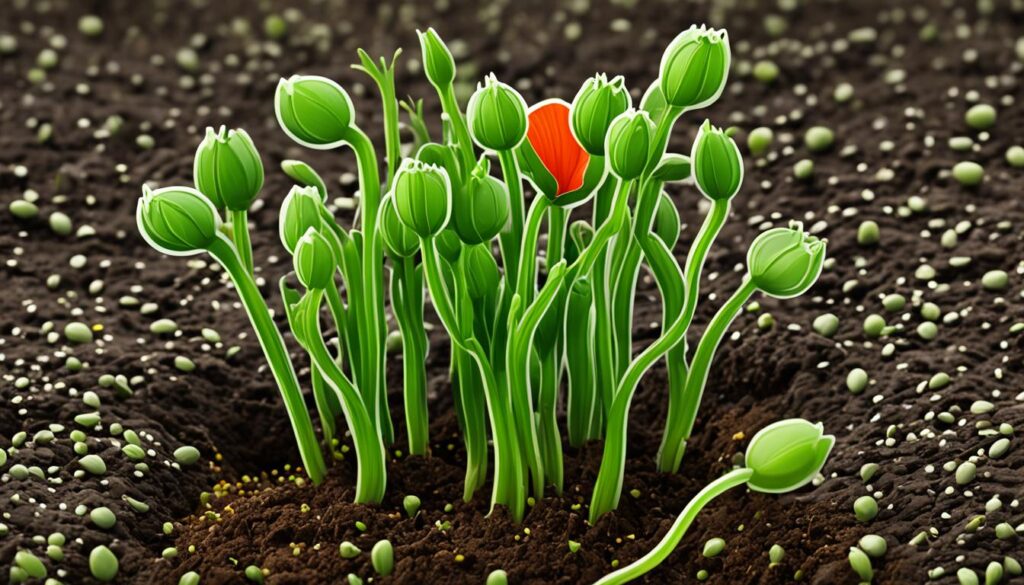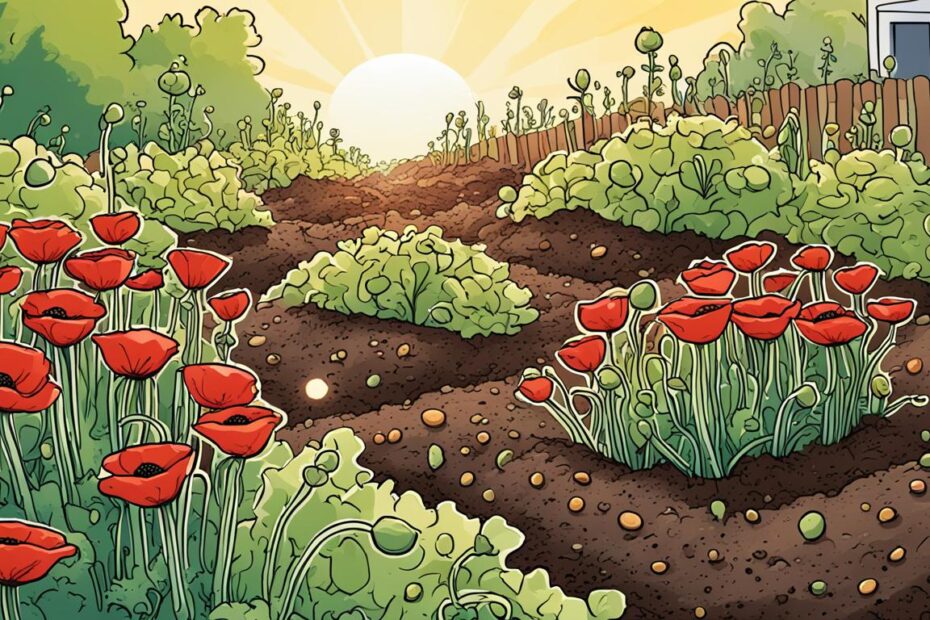Are you ready to unleash the vibrant beauty of poppies in your garden? But wait, have you ever wondered what the secret is to growing breathtaking poppy blooms? It all starts with the right soil. Because when it comes to poppies, the soil they’re planted in can make all the difference.
Whether you’re a poppy enthusiast or a curious beginner, understanding the best soil for poppies can help you unlock their true potential. From oriental poppies to field poppies and Himalayan poppies, each variety has its own soil preferences and requirements. So, it’s time to dig deep and uncover the secrets of nurturing these stunning flowers.
Key Takeaways:
- Discover the specific soil needs of different poppy varieties, including oriental, field, opium, and Himalayan poppies.
- Learn the essential planting and care tips to ensure your poppies thrive, from the best time to plant to proper watering techniques.
- Explore the methods of propagating poppies, from seeds to root cuttings, to expand your poppy collection.
- Find out the ideal planting locations for poppies in your garden, whether it’s borders, wildflower mixes, or containers.
- Get insider tips on selecting the best poppy plants when buying, and discover reputable online retailers to consider.
Growing Poppies: Planting and Care Tips
When it comes to planting poppies, selecting the right soil and providing proper care are essential for their growth and blooming. Here are some expert tips on planting and caring for poppies:
Planting Poppies
For optimal results, choose a well-drained soil in full sun when planting poppies. Different varieties have different planting preferences:
Oriental and Himalayan poppies should be planted in the spring.
Annual and biennial poppies can be grown from seeds directly sown into well-prepared soil.
Annual poppies should be sown in the spring or early summer.
Himalayan poppies do best in partial shade and damp soil.
Remember to follow the specific planting instructions for each poppy variety to ensure their successful establishment.
Caring for Poppies
Caring for poppies involves providing them with the necessary conditions to thrive:
- Regular Watering: Poppies, especially when in bud or bloom, require regular watering. However, avoid overwatering when they are dormant.
- Proper Support: Oriental poppies, known for their large flowers, may need supports to keep their blooms upright.
- Deadheading: Removing spent blooms not only improves the appearance of poppies but also encourages more flowering.
- Cutting Back: Cutting back oriental poppies after the initial blooming can lead to a second flush of beautiful blooms.
By following these care tips, you can ensure that your poppies thrive and continue to delight with their vibrant colors and delicate petals.
| Planting Tips | Care Tips |
|---|---|
| Choose well-drained soil | Provide regular watering |
| Plant oriental and Himalayan poppies in spring | Use supports for oriental poppies |
| Sow annual and biennial poppies directly into soil | Deadhead spent blooms for more flowers |
| Sow annual poppies in spring or early summer | Cut back oriental poppies for a second bloom |
| Provide partial shade and damp soil for Himalayan poppies | Avoid overwatering when poppies are dormant |
Propagating Poppies: From Seeds to Root Cuttings
Most poppies can be propagated by seed, but oriental poppies are best propagated from root cuttings. Oriental poppies are hybrids, so they may not come true from seeds. To propagate oriental poppies from root cuttings, follow these steps:
- Carefully lift a mature plant and trim off a section of root with the thickness of a pencil.
- Cut the root into 4cm lengths.
- Plant the root cuttings vertically in a pot with cutting compost.
- Cover the pot with a thin layer of grit and water.
- Leave the pots in a cold frame until little plants form.
- Pot the little poppy plants on.
By propagating oriental poppies from root cuttings, you can ensure that the new plants retain the characteristics of the parent plant and continue to produce stunning blooms.

| Benefits of Propagating Poppies from Root Cuttings | Benefits of Propagating Poppies from Seeds |
|---|---|
| You can maintain the unique characteristics of the parent plant. | Allows you to grow a large number of poppies at once. |
| Produces plants that are true to the parent variety. | Offers an affordable way to propagate poppies. |
| Results in plants that are more likely to have stronger, healthier root systems. | Allows for different genetic combinations and potential variations in the next generation of poppies. |
Where to Grow Poppies: Best Planting Locations
Poppies are incredibly versatile plants that can thrive in various environments. Whether you’re looking to add a burst of color to your garden or create a wildflower meadow, poppies can be the perfect choice. To ensure optimal growth and vibrant blooms, it’s important to consider the best planting locations for different poppy varieties.
Oriental Poppies – Perfect for Borders
Oriental poppies, with their large, show-stopping flowers, are an excellent choice for border plantings. These magnificent plants prefer full sun and well-drained soil. Their vibrant blooms can create a dramatic focal point and add a touch of elegance to any garden. Oriental poppies are sure to make a statement and attract attention from both humans and pollinators alike.
Annual Poppies – Ideal for Wildflower Mixes
Annual poppies are often included in wildflower mixes to create a meadow-like effect. These easy-to-grow plants can thrive in a variety of soil types, making them suitable for different planting locations. Whether you have clay soil, sandy soil, or loamy soil, annual poppies can bring a burst of color and natural beauty to your space.
Himalayan Poppies – Partial Shade and Moist Soil
If you prefer a cooler color palette and want to add a touch of tranquility to your garden, consider planting Himalayan poppies. These stunning perennials thrive in partial shade and moist soil. Their delicate blue flowers can create a peaceful ambiance and complement other shade-loving plants in your garden.
Purple Poppies – Thrive in Light Shade
Purple poppies, with their unique and captivating hue, can add a touch of mystery to any garden. These beauties prefer light shade and well-drained soil. Whether you plant them in a woodland garden or along a shady pathway, purple poppies are sure to create a striking visual contrast and captivate your senses.
While poppies can be grown in containers, they tend to perform better when planted directly in the garden. They thrive in a variety of soil types, including alkaline, acid, and neutral soils. Choose a well-drained soil in full sun for the best results, and watch your poppies bloom into stunning displays of natural beauty.
| Poppy Variety | Preferred Planting Location | Soil Type | Light Requirements |
|---|---|---|---|
| Oriental Poppies | Borders | Well-drained | Full sun |
| Annual Poppies | Wildflower mixes | Various (adapt to soil type) | Full sun |
| Himalayan Poppies | Partial shade | Moist | Partial shade |
| Purple Poppies | Light shade | Well-drained | Light shade |
Whichever poppy variety you choose, remember that proper planting locations and soil conditions are key to their success. By selecting the right spot for your poppies, you can create a stunning display of nature’s beauty and enjoy the vibrant colors and delicate flowers that these remarkable plants have to offer.
Buying Poppies: Tips for Selecting the Best Plants
When it comes to buying poppies, it’s important to choose healthy plants that are free from pests and diseases. Whether you’re looking for oriental poppies, field poppies, or opium poppies, selecting the right plants is crucial for a successful garden. Here are some tips to help you make the best buying decisions:
- Inspect for Health: Look for plants with vibrant green foliage and sturdy stems. Avoid any signs of wilting or yellowing leaves, as this may indicate poor health.
- Check for Pests and Diseases: Examine the plants closely for any signs of pests, such as aphids or spider mites. Also, watch out for diseases like powdery mildew or root rot.
- Consider Plant Form: Different types of poppies are available in various forms. Oriental poppies are typically sold as plants, while field and opium poppies can be grown from seeds. Determine which form suits your gardening preferences.
- Reputable Online Retailers: If you prefer to buy poppies online, consider reputable retailers like Thompson & Morgan, Suttons, and You Garden. These platforms offer a wide range of poppy varieties and ensure high-quality plants.
By following these tips, you’ll be able to select the best poppy plants for your garden. Remember to choose healthy specimens and take into account the specific requirements of each poppy variety. Now let’s explore the best poppy varieties to grow for stunning blooms.

Here are some additional tips for buying poppies:
“A healthy poppy plant is the foundation for a beautiful garden. Take your time to carefully inspect the plants before purchasing, and don’t hesitate to ask questions or seek advice from knowledgeable nursery staff. Happy gardening!”
Best Poppies to Grow: Top Varieties for Stunning Blooms
When it comes to growing poppies, choosing the right varieties can make all the difference in creating a garden filled with stunning and vibrant blooms. Whether you prefer classic white flowers, eye-catching orange-red hues, delicate red blooms, or a mix of yellow, orange, and red, there is a poppy variety to suit every taste and garden style.
| Poppy Variety | Characteristics |
|---|---|
| Papaver orientale ‘Perry’s White’ | Large white flowers |
| Papaver orientale ‘Turkenlouis’ | Orange-red flowers |
| Papaver rhoeas | Delicate red flowers |
| Papaver nudicaule (Icelandic poppy) | Mix of yellow, orange, and red flowers |
| Papaver commutatum (Ladybird poppy) | Delicate red flowers with black spots at the base of each petal |
“The right variety of poppy can transform your garden into a floral masterpiece. From the elegant Papaver orientale ‘Perry’s White’ to the fiery beauty of Papaver orientale ‘Turkenlouis’, each variety brings its own unique charm. Imagine a sea of delicate red Papaver rhoeas swaying in the breeze or the cheerful mix of colors provided by the Icelandic poppy. With the captivating Ladybird poppy, you’ll be mesmerized by its bright red petals adorned with enchanting black spots. So, take your pick and let these stunning poppy varieties grace your garden with their natural beauty.”
With these top poppy varieties, you can add a touch of elegance, vibrancy, and charm to your outdoor space. Whether you choose to plant them in flower beds or containers, these poppies are sure to create a breathtaking display that will captivate both you and your guests.
Stay tuned for the next section to learn valuable insights on growing poppies in containers and the considerations you should keep in mind to ensure their successful cultivation.
Growing Poppies in Containers: Tips and Considerations
While poppies are best grown in garden soil, they can also thrive in containers if necessary. Whether you have limited outdoor space or simply prefer the versatility of container gardening, growing poppies in containers can be a rewarding experience. Here are some tips and considerations to help you successfully grow poppies in containers.
Choosing the Right Container
When selecting a container for your poppies, it’s crucial to choose one that is deep enough to accommodate the plant’s long taproot. This taproot extends deep into the soil and plays a vital role in the plant’s stability and nutrient absorption. Opt for a container that has a depth of at least 12 inches to allow the taproot to develop fully.
Using Quality Potting Mix
To provide the best growing environment for your container-grown poppies, use a high-quality potting mix. Avoid using garden soil, as it can become compacted and hinder drainage in containers. A well-draining potting mix will ensure that excess water can flow freely, preventing the roots from becoming waterlogged. Look for a mix specifically formulated for container gardening or one that includes perlite or vermiculite to improve drainage.
Watering and Maintenance
Poppies grown in containers require regular watering to keep the soil consistently moist. However, be cautious not to overwater, as this can lead to root rot. Monitor the moisture level of the soil by inserting your finger about an inch deep into the potting mix. If it feels dry at that depth, it’s time to water. During hot and dry periods, you may need to water your container-grown poppies more frequently.
Additionally, when the poppy plant becomes root-bound, meaning the roots have filled the container and have no more room to grow, it’s essential to transplant it to a larger pot. If you prefer to keep the same container size, you can divide the plant by carefully removing a section of the root mass and replanting it in a new pot with fresh potting mix. This will give the plant renewed space to grow and thrive.
Winter Protection for Container-Grown Poppies
During winter, it’s important to provide adequate protection for your container-grown poppies to ensure their survival. One option is to bury the container in the soil, which acts as a natural insulator. You can also create an insulating silo around the pot using straw, hay, or leaves. Wrapping the pot with burlap and/or bubble wrap can further protect it from freezing temperatures. Alternatively, if you have space, you can move the container indoors to an unheated area such as a garage or basement.
| Container Requirements | Potting Mix | Watering Tips | Winter Protection |
|---|---|---|---|
| Deep enough to accommodate taproot | High-quality, well-draining potting mix | Keep soil consistently moist, but avoid overwatering | Bury container in soil, create an insulating cover, wrap in burlap, or move indoors |
By following these tips and considerations, you’ll be able to enjoy the beauty of poppies even if you have limited gardening space. Growing poppies in containers can bring vibrant colors and stunning blooms to your patio, balcony, or any other small outdoor space you have available. With proper care and attention, container-grown poppies can be just as rewarding as their garden counterparts.
Conclusion
With the right soil and proper care, poppies can thrive and produce vibrant blooms in your garden. Whether you’re growing oriental, field, opium, or Himalayan varieties, the key is to choose the best soil type and provide the optimal conditions for each type. Plant your poppies in well-drained soil, ensuring they receive full sun for maximum growth and flowering.
Remember to water your poppies adequately, especially during their blooming period, to keep the soil moist. However, be careful not to overwater them when they are dormant. Deadheading spent blooms will not only make your garden look neater, but it will also encourage more flowers to bloom and prolong the flowering season.
By following these care practices, you can create a thriving garden filled with the beauty of poppies. Whether you’re an experienced gardener or just starting out, poppies are a wonderful addition to any landscape. Enjoy the vibrant colors, delicate petals, and the joy they bring to your outdoor space.
FAQ
What type of soil is best for growing poppies?
Poppies thrive in well-drained soil. Oriental poppies prefer moist soil in full sun, while field poppies and opium poppies can tolerate drier, poorer soils. Himalayan poppies do best in slightly acidic soils and partial shade.
When should I plant poppies and how do I care for them?
Oriental and Himalayan poppies are best planted in the spring. Annual and biennial poppies can be grown from seeds directly sown into well-prepared soil. Provide regular water, especially when in bud or bloom, but avoid overwatering when dormant. Deadheading spent blooms can help prolong flowering.
How can I propagate poppies?
Most poppies can be propagated by seed. Oriental poppies are best propagated from root cuttings. Lift a mature plant, trim off a section of root, and plant the root cuttings vertically in a pot with cutting compost.
Where is the best location to grow poppies?
Poppies can grow in most soils, but for the best results, choose a well-drained soil in full sun. Oriental poppies are perfect for borders, while annual poppies are often planted in wildflower mixes. Himalayan poppies prefer partial shade and moist soil.
Where can I buy poppies?
Check for healthy plants without any signs of pests or diseases. Oriental poppies are typically available as plants only, while field and opium poppies can be grown from seeds. Some reputable online retailers to buy poppies from include Thompson & Morgan, Suttons, and You Garden.
What are some top varieties of poppies to grow?
Some top varieties include Papaver orientale ‘Perry’s White’ with large white flowers, Papaver orientale ‘Turkenlouis’ with orange-red flowers, and field poppy Papaver rhoeas with delicate red flowers.
Can I grow poppies in containers?
While poppies are best grown in garden soil, they can be grown in containers if necessary. Choose a deep container, use quality potting mix, water deeply, and provide winter protection if needed.
